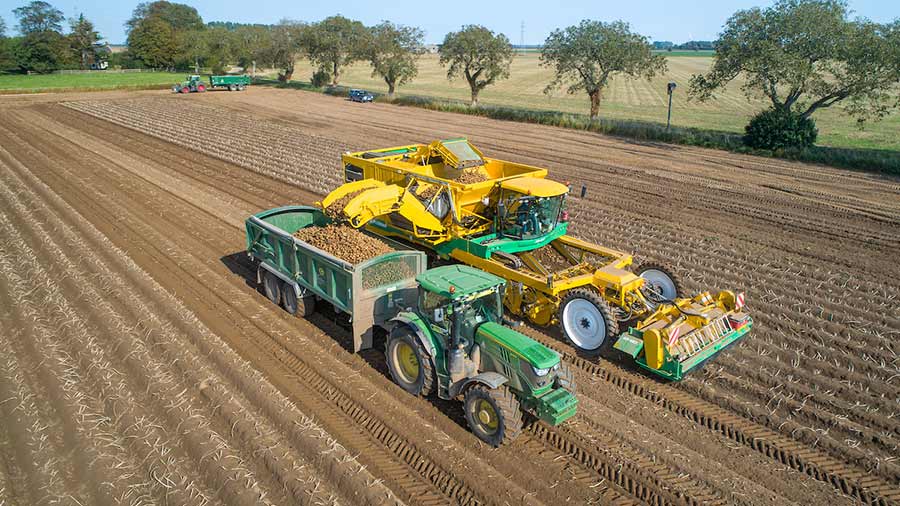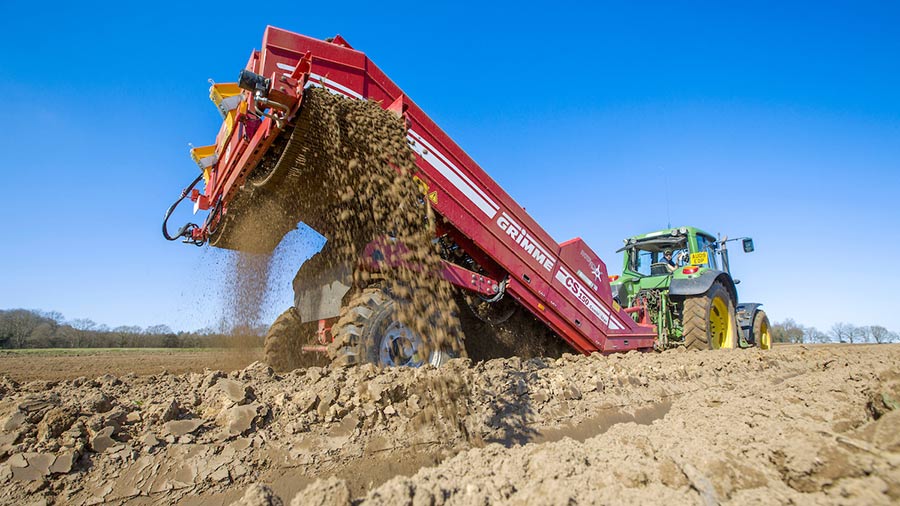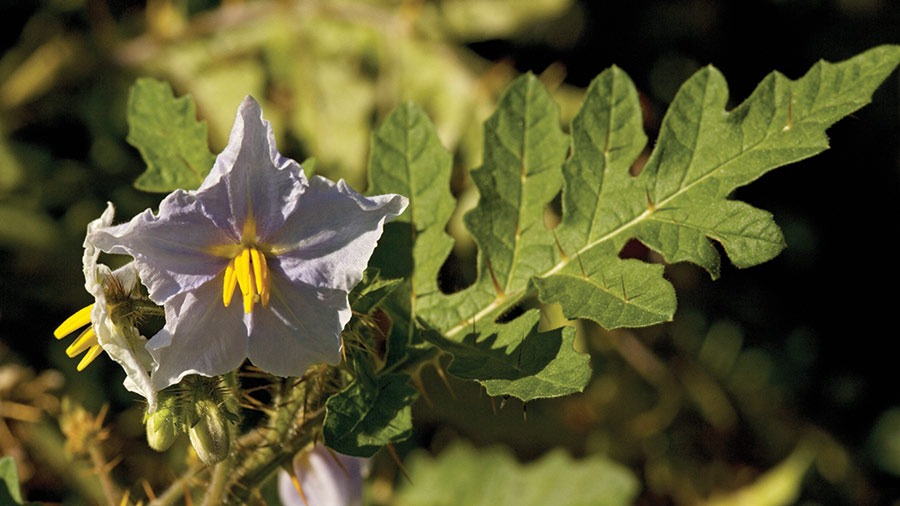How regen principles are being applied to potatoes for McCain
 © GNP
© GNP Securing a long-term sustainable supply of potatoes is behind McCain Food’s partnership approach to regenerative potato production, as it works with growers to reduce the impact of growing the crop.
Recognising that the challenges with potatoes are different to those of other crops, McCain vice-president for agriculture, James Young, says the company is listening to farmers as it develops a framework to measure progress.
See also: Video: Camera technology improves marketability for potato growers
“The improvements being made at the farm level are really exciting,” he reports.
“With 240 growers working with us to produce 700,000t of potatoes, we are committed to sourcing good-quality produce from the UK.”
Having previously been accused of greenwashing, James is keen to emphasise the company’s commitment to UK production.
“Our biggest customer McDonald’s has huge expectations, and we are working closely with them on the rate of change.
“There’s been no let-up in demand and we don’t want to import potatoes,” he stresses.
James believes there are six key regenerative principles that can be applied to potato production (see box), and says that the company’s economic supply chain includes farmer returns.
“Changing the way that things are done on farms comes with risks. That means the commercial model for regenerative farming must be different.”
Improving soil health, enhancing biodiversity and reducing the impact of synthetic inputs will help improve climate resilience, water-holding capacity and biodiversity, while reducing costs and emissions, he adds.
McCain smart and sustainable farming – six key principles
- Ensure farm resilience
- Armour soils, preferably with living plants
- Enhance crop and ecosystem diversity
- Minimise soil disturbance
- Reduce agrochemical impact and optimise water use
- Integrate organic and livestock elements
Ed Brown, head of agroecology with Hutchinsons, points out that growing potatoes in a regenerative system is more involved, but stresses that where the basic principles are applied, positive changes do follow.
“Good inroads can be made,” he says. “And it’s important to note that lessening the impact that the crop has on the environment doesn’t have to come with a yield cost.”
Ed has worked with John Bubb to introduce various changes and new practices on his Shropshire farm (see panel).
A fundamental step has been to get the soils functioning better and to rebalance the soil food web, leading to a healthier, more resilient system.
Soil organic matter (OM) levels have increased with the use of cover crops, improving water retention and reducing the need for irrigation.

© GNP
Fuel use has come down as cultivations have reduced and the farm’s carbon footprint is heading in the right direction, helped by input reductions.
However, blight sprays remain high, admits Ed. “We have bought more diversity into fields and worked on building healthier plants, as well as growing more resistant varieties, but we haven’t made a big impact yet.”
Gene editing may be able to help with this goal, but McCain is wary and efforts are currently being directed at conventional breeding techniques.
“As a family-owned company with responsibilities to our customers and our consumers, we are keen to keep making progress through conventional plant breeding,” confirms James. “But we recognise that it could have potential.”
Nutrient management is an area where there has been significant change for John Bubb, and Ian Robertson of Hutchinsons has helped with soil testing and sap analysis, which underpins a feed-to-need strategy.
Building fertility across the rotation has reduced the overall nitrogen (N) requirement and allowed the farm to move away from ammonium nitrate fertiliser, in favour of urea and foliar applications.
In addition, biologicals and organic acids have replaced phosphate fertiliser and a feed-the-crop approach has seen potash use drop.
“The upshot of getting the soil to work better has been a £345/ha saving,” reports Ian. “And the yield of 74t/ha was identical to that of the previous farm standard.”
He is still exploring how low the farm can go with nitrogen. “My feeling is that we can start with 50-70kg/ha of N and build it from there.”
In future, compost extracts will be evaluated on the farm and more will be done with plant diversity and input reductions.
“It’s working progress,” summarises Ed. “We are meeting the demands of retailers and consumers, providing home-grown potatoes with a better environmental profile from a profitable and resilient system.”
McCain framework for northern hemisphere regenerative growers |
|||
|
|
Beginner |
Master |
Expert |
|
Armoured soils – fields covered by living plants with an average normalised difference vegetation index (NDVI) value >0.25 and at least 30% of soil surface covered year-round |
90 days |
180 days |
270 days |
|
Crop diversity – different crop species grown over four years, with varied growth cycles and growth characteristics |
Four species, including grass and legumes |
Six species, including grass, legumes and a perennial |
Eight species, including a grass, legume, brassica and two perennials |
|
Soil disturbance – minimise tillage across the rotation |
Reduce potato crop tillage by one pass and either adopt conservation tillage or decrease tillage intensity by 10% |
Reduce potato crop tillage by two passes and adopt conservation tillage or decrease tillage intensity by 25% |
Reduce potato crop tillage by three passes and adopt conservation tillage or decrease tillage intensity by 50% |
|
Pesticide toxicity – choose crop protection products that reduce environmental and consumer impact (Environmental Impact Quotient) |
800 EIQ/ha |
500 EIQ/ha |
200 EIQ/ha |
|
Farm biodiversity – use of natural habitat and landscape features, with small natural habitats surrounding 70% of fields |
1% of non-cultivated land is natural habitat |
5% of non-cultivated land is natural habitat |
8% of non-cultivated land is natural habitat |
|
Inputs and water use – justify and manage inputs to reduce risk, use decision-support systems and technology for precise application |
All inputs applied using DSS or agronomist advice. GPS is used. |
Meet beginner level and supply 15% of crop nutrient needs from organic sources |
Meet beginner level and supply 30% of crop nutrient needs from organic sources |
|
Soil organic matter – measure and record soil health including OM, biological, physical and chemical properties every five years |
Target OM% increase based on local conditions and expertise |
Target OM% increase to be set over five years |
Target OM% increase to be set over five years |
| All growers must receive regenerative agriculture training, meet minimum indicator standards and carry out soil health assessments every five years. | |||
JM Bubb and Son, Shropshire

A DeCyst trap crop, to help with potato cyst nematode control, is grown in Shropshire farmer John Bubb’s rotation © Science Photo Library
Potatoes are grown for McCain Foods on 162ha of the 810ha farmed in Shropshire by John Bubb, who runs a diversified business that also includes wheat, oilseed rape and flowers in a six-year rotation.
A whole-farm approach is taken to soils and cultivations, with efforts to reduce working depth and eliminate the number of passes being made in potatoes complemented by using strip tillage to establish other crops.
Actions to de-intensify potato cultivations by less bed-tilling and tines fitted to destoners are paying off, and the purchase of a new potato harvester in 2019 has made a huge difference to operations and timeliness, reveals John.
“Having the right equipment – and enough of it – means that we don’t have to travel when the conditions aren’t right, which minimises soil damage.”
Being involved in a five-year research project to reduce the number of passes involved with potato planting is also helping, he continues, although it’s still early days and the soil’s high stone content is a challenge.
Multispecies cover crops are grown twice in the rotation – ahead of potatoes and flowers – and an eight-week catch crop is fitted in between oilseed rape and winter wheat.
The species mix has been fine-tuned with experience; brassicas aren’t included and oats don’t feature ahead of the flower crop.
Other plant diversity comes in the form of stewardship mixes and companion planting; the latter involving peas and beans being grown with potatoes for a nitrogen benefit and buckwheat with oilseed rape.
In wheat, this diversity is being introduced by establishing a living clover mulch, with the wheat being drilled in 50cm rows in a wide band and the clover grown between them.
A DeCyst trap crop, to help with potato cyst nematode control, is also grown in the rotation.
Along with appropriate variety selection and testing, this has helped bring nematicide use down to just 8% of the potato ground, where previously it had been 90%.
Re-ridging trials are being conducted to see if herbicide reductions can be achieved, but fungicides are proving to be more difficult, especially where blight is concerned.
“It can be slow progress but an exception to that is our fertiliser regime, which has changed massively, thanks to the use of soil testing and sap analysis,” highlights John.
“By increasing fertility across the rotation, we’ve reduced our nitrogen requirement and seen phosphorus (P) fertiliser use drop by 90% and potassium (K) fertiliser use fall by 35%.”

